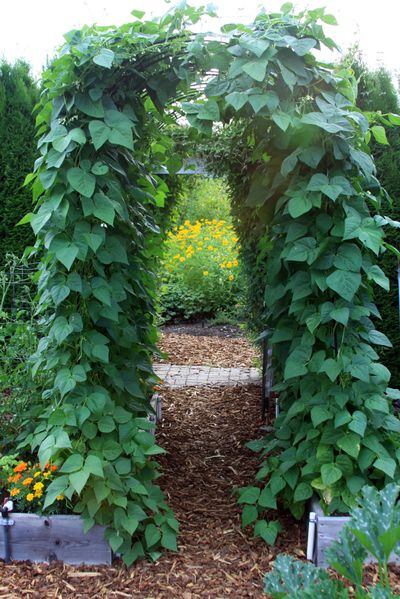Growing beans over an arbor pays big dividends

The plants didn’t get off to the best of starts because of cool temperatures in May and June but since the warm weather hit, they have been making up for lost time.
I grew Green Arrow Bush peas this spring and am very impressed with the results. While the vines are quite vigorous, they are also somewhat compact and have been very prolific.
I still enjoy growing pole beans over an arbor. This year, I’m comparing two varieties – Musica and Smeraldo – with the Italian pole bean I’ve grown for a few years to see which one will be the most productive. After the first two pickings, I can report that my old standby is the winner so far.
In early spring, I wrote about a tip I learned to get better germination from my carrot seeds. Fellow Master Gardener Rhonda Elliott taught me to plant the seeds as I normally would, water them in and then place boards over the rows of seeds for one week. This was to prevent a crust from forming on the surface of the soil, something that makes it difficult for the wimpy carrot sprouts to push through. The resulting germination was excellent.
For the first time ever, I’m growing a grafted tomato to see if all of the hype is true. These plants are tomato varieties that have been grafted onto very hardy and productive rootstock. The variety in my garden is Black Pear and I’m growing it alongside a non-grafted plant of the same variety. I’ll be writing about the results in a few weeks. In addition to the Black Pears, we’re growing Stupice, Italian Pompeii, Sungold and Amsterdam and have started picking our first few tomatoes.
Growing kohlrabi is another first for me. Their fleshy roots are quite intriguing and they’ve been really easy to grow. I should be able to start harvesting them shortly.
There are three raised beds planted with onion starts I got from Dixondale Farms. All are long-day varieties – Walla Walla Sweet, Copra and Big Daddy – which are ideal for our climate. The plants are growing vigorously and should provide an abundant harvest. We’ll eat the Walla Wallas first since they don’t keep well; we’ll let the others dry out prior to storing them for use over the fall and winter.
After having good success in growing and storing several winter squash varieties last year, I made room for even more this year. Sweet Dumpling, Delicata, Red Kuri, Sweet Meat and Table Queen are busily blooming and setting fruit. I’m certain the reason last year’s harvest kept so well in storage is because I cured the squash in the sun for two weeks prior to moving them to my basement; I’ll do the same routine this fall.
The eggplants and peppers are doing much better this season compared to last year when we also had a chilly spring and early summer. This year, I kept them under a floating row cover until they started blooming; I think they appreciated the extra warmth and got off to a better start.
The only major insect problem has been with slugs on our Baby Napa cabbage. Neither an application of diatomaceous earth nor organic slug bait has deterred these little troublemakers from ruining that crop. I remember when we didn’t even have slugs in Eastern Washington but our climate change seems to be helping them become more established here.